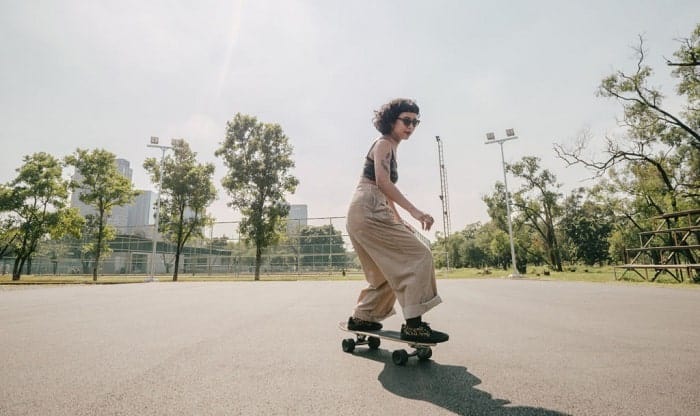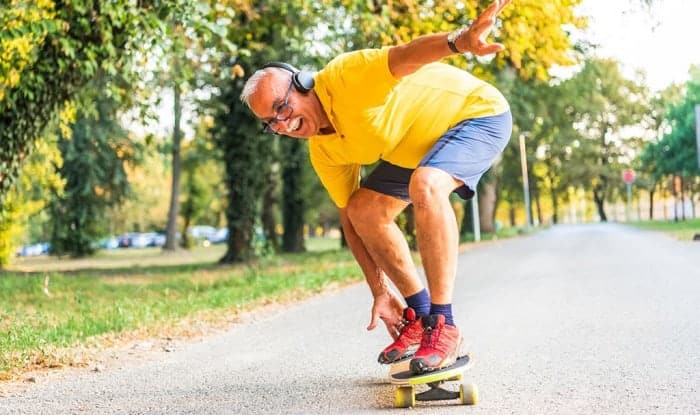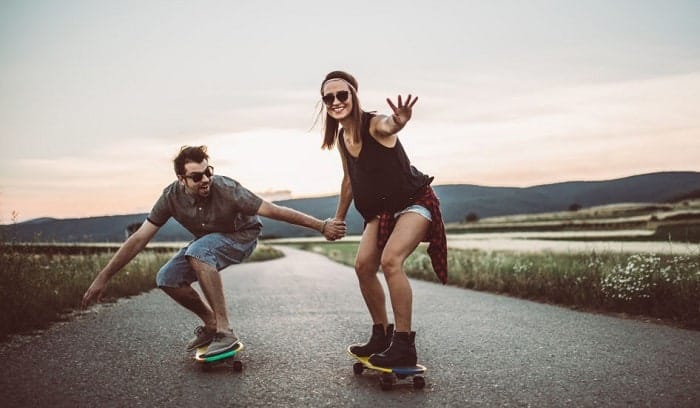Do you ever wonder how professional skaters go for flawless stops? One relevant aspect of skateboarding is knowing how to stop on a skateboard. This procedure is not only for merely taking your skateboard to a brake but is also a safety measure you have against accidents.
Learning some practical strategies when riding a skateboard will give you a competitive advantage over others who used to ride a skateboard without fundamental knowledge of braking. Let this article help, and guide you to the safest and most effective way of bringing your skateboard to a brake.
Table of Contents
What You Will Need
Before taking your skateboards out and performing the braking steps I’m going to teach you, here are a few things you need to prepare to ensure perfect execution.
Helmet
One of the most sensitive parts of your body is the head. Helmets are sturdy buckets of protection against accidental impact. Most helmets these days are made of either fiberglass composite carbon fiber or ABS plastic. Also, inside every helmet is a layer of protective cushion that neutralizes the effect of any impact.
When you ride under excessively sunny or rainy weather, helmets can also serve as protection against these elements. Note that the helmet you choose should be a snug fit to your head and not too wide.
Wrist guards
Whether newbies or pros, all skateboarders need wrist guards at all times. One reason is that the hands are your primary level of support during turns and falls. Wrist guards prevent injuries since it’s a human’s instinct to stretch his hands out to break the falling motion.
Some wrist guards cover only your palm, but others cover both sides of your hand, leaving only the fingers and arm extension unguarded. Pick the one that will keep your hands steady, especially during impact.
Elbow and knee pads
Not only volleyball players need these pads, but also everyone who has his knees and elbows prone to injury. The most exposed part of your knees is the patella. So, choose knee pads that come with cushions enough to absorb force.
For elbow pads, they should be impact-absorbing and thick enough to keep you protected from possible cuts. The majority of elbow pads today have a more minimalist design and are more advanced in durability compared to solid gears before.
Skateboard shoes
Your footwear should make you comfortable throughout your ride, even when practicing tricks. It doesn’t have to be expensive or high-end as long as it’s snug fit and firmly laced.
Most skateboarders prefer flat-soled sneakers of any brand. Shoes with gum and rubber soles are also usual with skateboarders since they grip well on almost any surface. On top of these, make sure that the pair of shoes you pick will not make you slip on the stepping surface of the skateboard no matter the angle you’re in when riding.
Shatterproof glasses
It is always necessary to have a clear vision of the road, and having shatterproof glasses is one way to do it. These lenses are not like your ordinary summer shades because they are more durable and have sport-customized designs.
This type of eye gear protects you from too much sun brightness and acts as a windshield for your eyes. That way, you get to keep your eyes calm and free from distractions.
Ways to Stop on Your Skateboard
There are plenty of ways to stop on a skateboard. Let me share with you the best approaches as well as their steps to execution.
The Foot Brake
This method is a friendly trick for beginners and is ideal for skating on plane surfaces. To do this, you have to place your dominant foot ahead, facing the nose of your skateboard. Lean your body forward as well as your head while keeping balance.
Once you have confidently transferred your weight to your dominant foot, put your other foot back down, heel first. Create a dragging motion as you slowly shift your weight to your non-dominant foot. Apply adequate pressure depending on how quickly you want to stop your skateboard. Smooth pressure yields a soft stop.
The Jump Off
Another simple method of stopping on a skateboard is through scraping it. Use this trick when riding slowly.
Start by moving your non-dominant foot to the back while keeping the other somewhere in the middle of the skateboard. Lean forward and try to balance your weight at your feet. Begin applying pressure on the tail of the skateboard using your non-dominant foot. Your board will then create friction with the terrain, slowing you down.
Should you feel uncomfortable scratching the end of your skateboard to the ground, you can use the heel of your non-dominant foot to scrape alternately.
Pop the Skateboard
Though this method applies to skateboards moving at low speed, this could still be tricky. To do this, you need perfect timing between throwing your skateboard up and getting stable coming off it.
As soon as you feel your skateboard going slow enough, kick the tail of the board down. Your skateboard then ollie pops into the air. Catch the nose of your skateboard with your hand as soon as it gets off your feet.
Powersliding
This trick is not necessarily open to pros alone but also those confident enough to pull this off.
Begin by shifting your weight to your heels as you lean a bit forward. Slide at a 90-degree angle using your front foot as a pivot. Be sure your hips and shoulders move with you to execute well. Pull the other end of your skateboard using your back foot. Lean back to help slow down the skateboard, and you regain balance.
Be careful you don’t execute this method when you need an abrupt stop, especially when you’re in traffic. Click here for more details how to power slide on a skateboard.
Slide Stop
Skateboarding cannot be this thrilling without this method of braking. This trick is the best you can do to stop when going downhill.
Like most skateboard braking methods, place your front foot forward right on top of your board’s front bolts. Using your body as a pivot, make a 180-degree sharp turn to the side. Bend your knees a bit and lean forward to maintain balance.
If you feel like falling off motion, place your hands in front of you for stability. You can lift your hands back once the skateboard halts completely.
There are more braking styles you can enjoy as long as you keep practicing. Take note that the braking methods have specific purposes. So, be keen enough to know which one works best with your speed, trajectory, and type of skateboarding ground.
Conclusion
The more tricks and styles you know, the better you love your skateboards. Riding your board is not only about how fantastic its parts are but also how great it can perform. Skateboard braking should be of high importance because it will keep you safe from accidents.
By knowing how to stop on a skateboard, you are also improving in many aspects. Plus, you get to help other beginners trying to be better as well. Did you learn much from this tutorial? Share what you think in the comments section.

I am Michael, and I have been enjoying this fun sport for seven years. And nothing is better than having a community to share our passion for those thrilling tricks. I am ready to tell you all I know about skateboarding, showing you how to choose a good board and trick to start and how the practice goes. Stay tuned!




